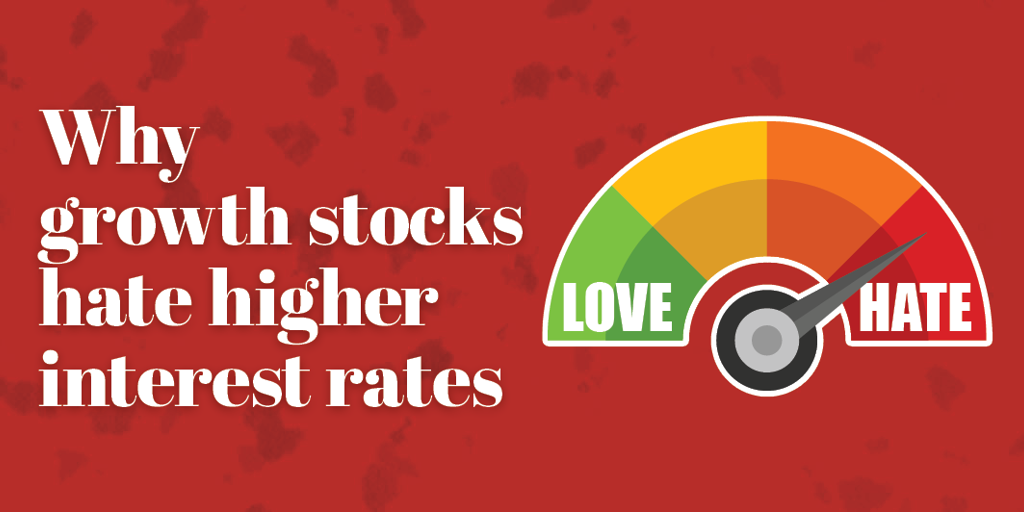


Why Growth Stocks Hate Higher Interest Rates
The reaction to COVID-19 has been a case study in economic theory. Direct cash payments from the government to individuals and corporations were made for the first time in 2020. This experiment in fiscal and monetary policy will be studied by economists for decades. There are many areas of exploration, but I am going to limit this discussion to growth stocks.
Before we identify the difference between a growth stock and a value stock, we need to review what a share of stock represents. A share of stock is simply a very small ownership piece of a company. As an owner, you are entitled to your share of the company’s future profits for as long as you own the stock. This right to future profits is what gives stock its value, which can be calculated with relative precision. The challenge in investing is not the precision of the calculation, but rather the ambiguity of the inputs into the calculation. Allow me to explain.
The universal law of finance is this: The current value of any asset is the present value of all future cashflows. This applies to stocks, bonds, even rental properties. Unfortunately, the future is uncertain, making the “all future cashflows” component of the law uncertain. And what does “present value” mean?
Present value underlies the understanding that cash today is better than a promise of payment in the future. Present value explains why the lottery lump sum payment is so much less than the 20-year annuity total. What is not well understood is the impact that interest rates play on determining the present value. Let’s use a simple example to explain.
Assume I win the lottery with a $300,000 payout over three years. Let’s assume I don’t want to wait three years to get my money. I could create my own immediate payout by taking out a loan and paying it back with the annual lottery payments. I would have to pay interest on the loan, so I could not borrow the full amount. Assume I can borrow at 10%. My loan would look like the following:
- Borrow $90,909 + 1 year of 10% interest = pay off loan with $100,000 in one year
- Borrow $82,644 + 2 years of 10% interest = pay off loan with $100,000 in two years
- Borrow $75,131 + 3 years of 10% interest = pay off loan with $100,000 in three years
Therefore $300,000 paid out over three years is worth $248,684 ($90,909 + $82,644 + $75,131) when interest rates are 10%. But what happens when interest rates increase to 20%? We can calculate this same number by a process called discounting, and the math breaks down as follows.
We discount a future cashflow by dividing it by “1 + Interest rate” times the number of years until the payment is received. The same three-year annuity calculates as follows with a 20% interest rate:
- Payment 1 year from now: $100,000/(1.20)1 (1 year of 20% interest) = $83,333
- Payment 2 years from now: $100,000/(1.20)2 (2 years of 20% interest) = $69,444
- Payment 3 years from now: $100,000/(1.20)3 (3 years of 20% interest) = $57,870
At 20% interest, the present value of three $100,000 payments is $210,647 ($83,333 + $69,444 + $57,870). As you can see, the higher the interest rate, and the further into the future, the less valuable that future payment is today.
But what happens to the calculations if the future payments grow each year? (This is what we would expect from a growing company). Let’s see what happens when future payments grow at 20% in a 10% interest rate environment.
- Payment 1 year from now: $100,000/(1.10)1 (1 year of 10% interest) = $90,909
- Payment 2 years from now: $120,000/(1.10)2 (2 years of 10% interest) = $99,174
- Payment 3 years from now: $144,000/(1.10)3 (3 years of 10% interest) = $108,189
At 10% interest, the present value of the three $100,000 payments growing at 20% is $298,272 ($90,909 + $99,174 + $108,189).
There are two takeaways from all this math.
- A growing future cashflow is worth more than a stable one, and the faster it grows the more valuable it becomes.
- Higher interest rates make all cashflows less valuable.
Armed with these two concepts, we can finally address why growth stocks hate higher interest rates.
The first reason is obvious: Higher interest rates make future cashflows less valuable. Therefore – all else being equal – when interest rates rise, future earnings become less valuable today because they must be discounted at a higher rate.
Higher interest rates also make the growth of earnings more difficult. For a company to grow, it must have access to capital to build factories, hire staff, and expand operations. Higher interest rates make that capital more expensive. This inevitably slows growth, sending the two factors that drive a growth company’s value in the wrong direction when interest rates rise.
It is not coincidence that the growth-heavy QQQ (Nasdaq 100 ETF) advanced at nearly double the rate of the DIA (Dow ETF) between April 1, 2020 and November 30, 2021 (QQQ + 116%; DIA + 59.6%)* when interest rates dropped to zero and Paycheck Protection Program loans were flowing into the economy. Neither is it a coincidence that the Nasdaq has sold off two to three times the rate of the Dow in 2022* as the Federal Reserve has announced it will be raising rates and shifting from quantitative easing to quantitative tightening.
The stock market has many mysteries, but behind some of them is fundamental mathematical logic.
* Return numbers based upon market closing prices on days listed. 2022 data based upon year-to-date performance thru April 30, 2022
Warren Hurt is Chief Investment Officer for F&M Trust in Chambersburg, Pa.
Recent Articles
Join our e-newsletter
Sign up for our e-newsletter to get new content each month.






















